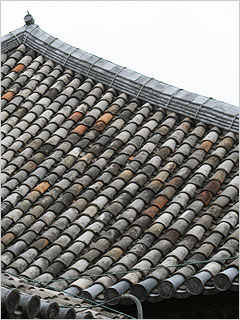A type of smooth, lipless, semi-cylindrical cover tile that tapers from its broader front end to a narrower back end. Lipless tiles are set over the seams of the broad, slightly concave tiles *hiragawara 平瓦 laid on the roof sheathing. The wider ends of the semi-cylindrical tiles overlap the narrower ends of those in front. Tiles are set from the eave end to the ridge. This type differs from the usual semi-round, cover tile *marugawara 丸瓦 which is made with a lip to interlock with the next tile. The use of lipless tiles is probably the oldest roofing technique. They are known to have been used on the roofs of the original buildings of Houkouji 法興寺 (Asukadera 飛鳥寺) and Gangouji 元興寺, both in Nara. Today the best examples are on the roofs of Gangouji Gokurakubou Zenshitsu 元興寺極楽坊禅室 and Hondou 本堂. Although most of the the lipless, semi-cylindrical tiles at Gangouji date from the Kamakura period, among them are some reddish brown tiles brought from Asukadera, and are dated to the 7c.
|


